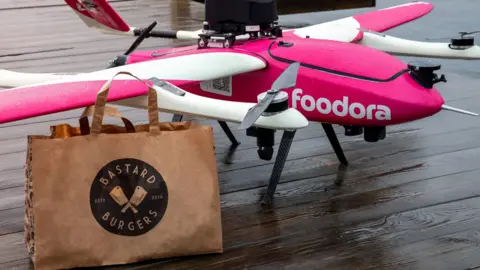Business
Why I Don’t Blame AI After Losing My Job As a Software Engineer

This as-told-to essay is based on a conversation with 59-year-old Marc Kriguer, a software engineer who has been laid off multiple times. His employment history has been verified by Business Insider. This essay has been edited for length and clarity.
I fell in love with computers and writing programs when I was in fifth grade. I debugged somebody else’s code a month before turning 10.
People didn’t have personal computers in the late 1970s, and people didn’t talk about becoming a software engineer, but I knew then that I wanted to do something with computers.
I’ve been a software engineer for 28 years now, and in the last 18, I’ve lost my job four times.
My first layoff happened around 2008 at Sun Microsystems. Starting in 2002, there were layoffs nearly every year, and I survived the first few. However, eventually, my group was hit pretty hard, and Oracle acquired the company soon after.
I experienced three more layoffs after that. In 2019, I was one of the principal engineers laid off from a plagiarism-checker company. I was laid off again at the start of COVID by a different company because their revenues fell significantly in just one month.
Then two months ago, I found out that my position at Walmart Global Tech as a principal software engineer was being eliminated along with roughly 1,500 other people.
I don’t think AI is the reason for software engineer layoffs
AI has changed the job landscape in some ways, but I don’t think it’s causing more layoffs.
In the last couple of months of my job, Walmart started pushing everybody to start using an AI-powered tool to help write code. I was one of the few stragglers against that idea. I really felt that human-written code is better than AI-written code.
While I don’t think AI is the best at writing code, I think it can be helpful with evaluating code. We used a different tool that basically powered code reviews, and I thought it was well-made.
A whole lot of jobs now require AI experience, and I don’t have it, so I feel somewhat limited in what I can search for. Most of the jobs that I’m applying for either don’t involve AI or indicate that you’ll learn it on the job. They just want coding experience, and they know that AI is a skill that can be learned.
I feel like I don’t have to worry about not having direct experience working with AI yet, but I think two years from now all the jobs out there will be looking for AI.
Companies hire too quickly
In the last three years, the number of people affected by tech layoffs has gone up significantly.
I’m not sure what drove the reorganization and layoff at Walmart, but the common thread between the other layoffs I’ve experienced is cost-cutting.
Companies don’t have the revenue to support their costs, so they reduce the number of employees. I think if companies hired fewer people to begin with, they would be more stable. It’s kind of the nature of the way that venture capitalists finance these companies. They give them a whole bunch of money in one fell swoop, and the companies take on more than they can afford long-term.
I think part of the reason software engineers are targeted specifically is their higher income. When a company is trying to reduce costs, it may see that it would have to get rid of fewer people overall by cutting more software engineers. Or, it may have already built the product, and companies don’t think they need the engineers anymore.
The issue is that you do need engineers. Bugs will turn up, and you eventually need to revisit the code. You can’t just assume, “Okay, we finished our product, we’re done. We don’t need the engineers anymore.”
Even though I’ve lost my job several times, I’ve never looked for a job for more than five months. This time around, I’ve applied to maybe 40 jobs and interviewed with about 15 companies so far.
I really haven’t looked around to see what the market is for brand-new engineers, but I haven’t noticed a decrease in demand for software engineers in general. The role may not be growing in demand, but it also doesn’t seem to be shrinking.
Business
Elon Musk announces plans for ‘Macrohard’ company to rival software giant Microsoft: ‘Purely AI’

Photo Credit: Getty Images
Tech billionaire Elon Musk has once again turned heads, this time by announcing that his AI company, xAI, is working to develop a version of software-giant Microsoft run exclusively on artificial intelligence.
“Join @xAI and help build a purely AI software company called Macrohard,” Musk posted to his social network X. “It’s a tongue-in-cheek name, but the project is very real!”
While Musk has had a long history of trolling or making proclamations that have never come to fruition, there was some evidence that Macrohard was more than just an online joke.
The U.S. Patent and Trademark Office website showed that xAI filed a trademark request for “macrohard” on Aug. 1, 2025.
The application requested exclusive use of the Macrohard name in the arena of “downloadable computer programs and downloadable computer software.”
In his post, Musk explained why he believed an exclusively AI software company was a realistic possibility.
 Want to go solar but not sure who to trust? EnergySage has your back with free and transparent quotes from fully vetted providers that can help you save as much as $10k on installation.
|
“In principle, given that software companies like Microsoft do not themselves manufacture any physical hardware, it should be possible to simulate them entirely with AI,” he wrote.
Were Macrohard to become its own company, completely AI-run or not, it would become just the latest in a long list of Musk-led ventures, including xAI, Tesla, The Boring Company, SpaceX, Neuralink, and X Corp, according to Business Insider.
Across his many ambitious projects, Musk increasingly has placed his focus on artificial intelligence and robotics.
Despite Tesla‘s being the No. 1 maker of EVs in the United States, Musk famously has said that Tesla’s self-driving technology was “the difference between Tesla being worth a lot of money and being worth basically zero,” per The Washington Post.
TCD Picks » Upway Spotlight
💡Upway makes it easy to find discounts of up to 60% on premium e-bike brands
Further, at a 2024 Tesla shareholder meeting, Musk boasted that he believed the company’s Optimus robot could one day lead the company to a $25 trillion market capitalization, CNBC reported at the time.
As CNBC pointed out, when Musk made these remarks, the market capitalization for the entire S&P 500 was $45.5 trillion.
Musk himself has admitted to being “pathologically optimistic,” per CNBC, about his own projects.
It’s difficult to assess the potential energy impact of using AI to create an entire software company and operating system to compete with Microsoft. It may require a lot of energy and cooling resources for data centers to accomplish, though as is always the case with AI, if an AI project can save significant human time that could include human resources such as commuting, food, and drink that could be applied toward enabling people to do other work, at some point the scale can tip — of course, as long as the ends justify the means with a functional product.
In many cases, people have cited that AI has appeared impressive only to produce many flaws under the surface that rendered its use fruitless for a particular project. A famous example is a viral X post in which user @vasumanmoza jokingly summarized the results of using AI to refactor a code base: “It modularized everything. Broke up monoliths. Cleaned up spaghetti,” they wrote.
“None of it worked. But boy was it beautiful.”
While only time will tell whether Macrohard or some other exclusively AI-run software company poses a risk to the future of tech behemoths like Microsoft, one thing seems certain: Musk will continue to put his significant financial clout and social capital behind AI and robotics.
Join our free newsletter for good news and useful tips, and don’t miss this cool list of easy ways to help yourself while helping the planet.
Business
Will drones deliver your next hot food order?

MaryLou CostaTechnology Reporter
 Aviant
AviantMeal delivery is a luxury city dwellers take for granted – but more options are opening up for non-urban residents.
Boasting nearly 700,000 islands collectively, Sweden, Norway and Finland are home to the most islands in the world, their coastlines dotted by archipelagos that have shaped their history and culture.
While a number of the islands are accessible by ferry and bridge to residents of the region’s cities, there’s one thing locals are often missing: hot food delivery to their door, a service their city cousins probably take for granted.
But Norwegian start-up Aviant wants to change that, by establishing the region’s first food delivery service by drone – starting on the Swedish island of Värmdö.
Värmdö is just eight miles (13km) from Stockholm as the crow flies, and accessible by car, bus and ferry. But its population of around 46,000 – rising to up to 100,000 in the summer – has few hot food delivery options.
During a video call, Aviant co-founder and CEO, Lars Erik Fagernæs, shows me a map of the islands closest to Stockholm.
“All of the white and blue squares are where (delivery services) Foodora and Wolt have a service, and all of the black squares are where they don’t,” says Mr Fagernæs, who is based in the Norwegian city of Trondheim.
“As you can see on the map, there are 87,000 people who don’t have access to a home delivery service. These people live in what you would call suburbs, and would want to order takeaway food, but they just don’t have an option.”
Since February, though, residents of Gustavsberg, the main town on Värmdö, and surrounding areas, have been able to order freshly made burgers from Scandinavian chain Bastard Burgers directly to their door via drone, using Aviant’s technology.
The cost of delivery is comparable to that of a car or bike service, as drones take out the cost of the driver.
At the moment Aviant is in a “beta phase” – only delivering 10 items a week, while they check everything works.
But the plan is to scale up as the year goes on.
 Aviant
AviantAviant is also set to launch a similar service on the Norwegian peninsula of Nesodden – just four miles in distance from Oslo, but a 29-mile road journey. Mr Fagernæs demonstrates once again on a map.
“All the white is where you don’t currently have a food delivery service. So it’s about 100,000 people that’s going to now have access to home delivery that didn’t have it before,” he says.
It hasn’t been a straightforward process to perfect, Mr Fagernæs admits, as several trials were needed to ensure the food stayed hot and fresh during the maximum flight time of up to 10 minutes, over a radius of up to six miles.
“We have been testing this for three years, and in the beginning, there were a lot of soggy fries,” he recalls. “But we have improved the isolated container the burger goes in, and now we know it arrives warm, even in the winter months.
“People go crazy for it. They call their neighbors and their grandma. They think it’s like a UFO delivering their food.”
Mr Fagernæs hopes the two pilot services will provide the “recipe”, as he describes it, to embark on a full-scale rollout across Scandinavia, where many communities like those on Värmdö and Nessoden are beholden to their geography. He points back to the map.
“We don’t have huge cities, but these areas are viable for drone delivery, where they are on the border of urban with rural, which is very hard to serve by car, and that is a lot of the population in Scandinavia,” says Mr Fagernæs.
Aviant has identified around 40 bases across Scandinavia to expand to over the next two years, and sees similar geography in Canada, which has over 52,000 islands, and the north eastern region of the US, characterised by lakes, mountains and islands.
And what about the weather. Mr Fagernæs admits high winds will ground the drones occasionally, but expects the service to have 90% uptime.
 Getty Images
Getty ImagesAs for flying drones to deliver food into really remote areas, Aviant is one of a number of drone firms to have tested the waters, but found the numbers did not add up.
Starting in 2022, Aviant delivered Thai, Italian and sushi to residents outside of Trondheim. But that service was ended in August 2023.
Meanwhile, in 2022, UK firm Skyports delivered school meals to children in the Orkney islands, funded by Argyll and Bute Council, and temporarily ran a “fish and chip Fridays” delivery service to the wider community.
Similarly, German firm Wingcopter delivered everyday goods to rural residents in 2023 as part of a government partnership. In China’s eastern Zhejiang province, a local council is funding drone delivery of hot meals to elderly villagers isolated in the mountains.
But continuing these services without a government or corporate sponsor is not commercially viable.
Given the distances, the cost of delivery would be prohibitive for the person ordering, and too much for the outlet providing the food to waive. And, being rural areas, there aren’t enough locals to generate sufficient orders to begin with.
 Skyports/Royal Mail
Skyports/Royal MailSkyports has, however, been running a drone delivery service with Royal Mail across the Orkneys since 2023, and is looking at how the drones used in that can be repurposed to resurrect the hot meal delivery service, this time for all residents.
“We haven’t yet opened it up to other non-Royal Mail users as it’s currently strictly a Royal Mail service. But absolutely, we can be looking at when those drones aren’t in use, how we could be taking cargo from outlets on the mainland to the islands.
We would have to look at what the premium charged would be, as it will be important to lower the cost. Today we’ve just been focusing on getting the service right before we look at that expansion,” explains Alex Brown, Skyports director.
“You could absolutely make something like that work. The more you could utilise the drone, the better.
“So there are models where you have an anchor customer who’s underwriting that core cost, then you can incrementally bolt on new commercial opportunities to bring in additional revenue, and then a new service for people using it.”
Apart from making the finances stack up, in the UK, commercial drone operators must work closely with the Civil Aviation Authority to designate a segregated air space they can operate in, to avoid collisions with other aircraft, and minimise the risk of a crash to people on the ground.
While this prioritises safety, it makes the UK drone market far more difficult to enter than in Europe, Asia, or Australia, as Skyports’ Mr Brown notes.
Rural operators can, as he explains, make the case that they are operating in atypical air space, or space that isn’t likely to have other aircraft flying in it or many people below, as well as demonstrate that they’re using high tech navigation and hazard detection technology – options Mr Brown says the UK government is becoming increasingly open to, and is encouraging for entrepreneurs in the sector.
“It is getting easier, and to give the UK government credit, they are making good progress,” he says.
Business
Children as young as 11 tempted to try betting after being ‘flooded’ by celebrity endorsement | Gambling

Children as young as 11 feel tempted to try betting after being “flooded” by celebrities and sports stars promoting it, according to two reports that found nearly 90% of children aged 13-17 are exposed to gambling content online.
The UK’s leading gambling charity, GambleAware, which commissioned the reports, urged regulators and policymakers to address social media accounts and influencers producing betting content on platforms such as YouTube, Instagram, TikTok and Twitch in light of the findings.
In one survey of 2,100 children aged 11-17, a quarter said seeing a celebrity gambling, or advertising it, had made them want to follow suit, rising to more than a third (36%) among boys aged 16-17.
This was despite the fact that almost four in five children agreed that nobody under the age of 18 should be exposed to content and advertising about gambling. The legal age to bet is 18.
In a second study, based on focus groups with children aged 13-17, 16% reported seeing content creators sharing links and sign-up codes for gambling operators, while 14% reported seeing them sharing betting tips and tricks.
The reports warned about content produced by mainstream UK operators as well as unlicensed sites promoting newer or unregulated products associated with video games such as “skins betting” and “loot boxes”.
Both involve the use of in-game digital items that have value to players and can be traded, staked or won via mechanisms that replicate real-life gambling.
Niks Kolosnicins, 24, developed a gambling addiction that severely disrupted his schoolwork and lasted into his university years.
“I used to see a huge amount of gambling ads when watching online streamers and esports – and with my favourite influencers promoting gambling, and many of my friends regularly betting, gambling became normalised for me,” he said.
Children who contributed to the study referred to seeing well-known sports stars in gambling content.
The Labour MP Beccy Cooper, who has called for a new gambling act to replace 2005 legislation introduced under Tony Blair’s government, said existing laws were “failing to protect children from online gambling marketing where influencers portray gambling as socially acceptable or aspirational”.
She added that “future generations should look back on this era of proliferation, targeting and sports gamblification with the same level of disbelief”.
The Liberal Democrat peer Don Foster described the report as “extremely concerning” and called for greater scrutiny of gambling advertising.
Heather Wardle, a professor of gambling research and policy at Glasgow University, said content seen at an early age can mean that gambling becomes “embedded deeply within social practices”.
“Evidence shows there is a real risk of escalating harms among this already higher-risk age group,” she added.
The previous government and Labour have taken steps to tighten up elements of gambling regulation – including cutting the maximum stake on online slot machines to £5 – but have stopped short of strict curbs on advertising.
Zoe Osmond, the chief executive of GambleAware, said: “It is unacceptable that children’s environments continue to be flooded with age-restricted content.”
A Department for Culture, Media and Sport spokesperson said: “We recognise the impact harmful gambling can have on individuals and their families, and we are absolutely committed to strengthening protections for those at risk, including children and young people.
“There are already a range of robust rules in place on gambling adverts, including rules to ensure adverts are not targeted at or strongly appeal to children.
“We will continue to work closely with the gambling industry to ensure that advertising is appropriate, responsible, and does not exacerbate harm.”
The Guardian approached the Betting and Gaming Council for comment.
-

 Business3 days ago
Business3 days agoThe Guardian view on Trump and the Fed: independence is no substitute for accountability | Editorial
-
Tools & Platforms3 weeks ago
Building Trust in Military AI Starts with Opening the Black Box – War on the Rocks
-

 Ethics & Policy1 month ago
Ethics & Policy1 month agoSDAIA Supports Saudi Arabia’s Leadership in Shaping Global AI Ethics, Policy, and Research – وكالة الأنباء السعودية
-

 Events & Conferences3 months ago
Events & Conferences3 months agoJourney to 1000 models: Scaling Instagram’s recommendation system
-

 Jobs & Careers2 months ago
Jobs & Careers2 months agoMumbai-based Perplexity Alternative Has 60k+ Users Without Funding
-

 Funding & Business2 months ago
Funding & Business2 months agoKayak and Expedia race to build AI travel agents that turn social posts into itineraries
-

 Education2 months ago
Education2 months agoVEX Robotics launches AI-powered classroom robotics system
-

 Podcasts & Talks2 months ago
Podcasts & Talks2 months agoHappy 4th of July! 🎆 Made with Veo 3 in Gemini
-

 Podcasts & Talks2 months ago
Podcasts & Talks2 months agoOpenAI 🤝 @teamganassi
-

 Mergers & Acquisitions2 months ago
Mergers & Acquisitions2 months agoDonald Trump suggests US government review subsidies to Elon Musk’s companies





















